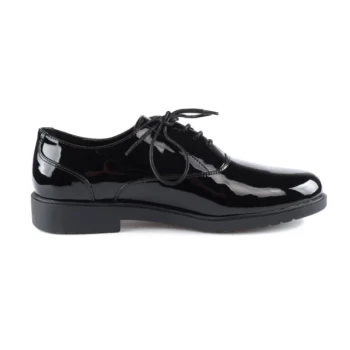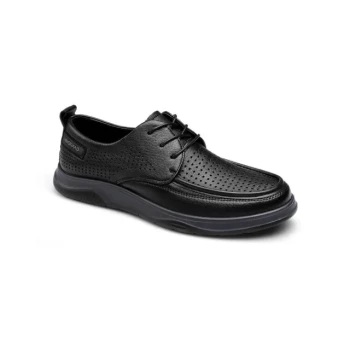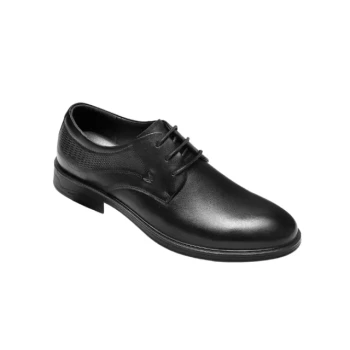My goal here is to be your trusted advisor, and that starts with understanding your needs. I see that you're looking for guidance on selecting women's dress shoes, and I know that this can be a complex decision. You're not just looking for something stylish; you need shoes that are also comfortable, practical, and a good value. That's why I'll focus on providing you with actionable insights that help you avoid common pitfalls.
Choosing the right dress shoe isn't about finding a single "perfect" pair; it's about matching the shoe's specific design characteristics to the demands of the occasion and your individual needs.
Deconstructing the Shoe: Beyond Aesthetics
Let's dissect what makes a dress shoe work – or not.
The Critical Role of Heel Type and Height
The heel height and shape significantly impact stability and how long you can comfortably wear a shoe. While a stiletto might be stunning for an evening event, a block heel provides far greater support for all-day wear. The heel shape, like a kitten heel or a platform, will also affect the ease of walking and overall comfort.
Material Matters: Breathability and Durability
The material directly affects both comfort and longevity. Leather molds to your foot and breathes, while synthetic materials might trap heat, leading to discomfort. Think about the wear-and-tear the shoe will receive.
The Importance of Sole Construction
A flexible and well-cushioned sole is key to all-day comfort. Look for a sole that offers good grip and supports the natural movement of your foot. A shoe with poor sole construction will feel like a punishment on cobblestone streets.
Understanding Arch Support
Proper arch support is crucial for preventing fatigue and foot pain. Ensure that the shoe's insole or built-in arch support aligns with your foot's natural arch. This will make a huge difference in long-term wear.
Defining Your "Intended Use"
The single most important factor is the shoe's purpose.
The All-Day Office Shoe
If you're looking for an all-day office shoe, prioritize comfort and support. Consider a block heel under two inches, a durable leather upper, and good arch support.
The Special Occasion Shoe
For a formal event, you might prioritize aesthetics over absolute comfort. However, still consider the heel height, the material, and how long you'll be on your feet. Bring a pair of supportive shoes for dancing!
The Commuting Shoe
If you're walking or commuting, practicality is paramount. Loafers, block heels, or even stylish flats are excellent choices. They should offer support, protection, and enough versatility to match various outfits.
Understanding the Trade-offs
Be realistic about these often unavoidable compromises.
Style vs. Stability
Higher, thinner heels are inherently less stable. The look is often worth it for a short event. But for everyday wear, opt for a lower, wider heel or a more supportive construction.
Initial Comfort vs. Long-Term Wear
A shoe that feels comfortable for a few minutes in a store might not be supportive enough for prolonged wear. Focus on shoes with structural support, not just soft cushioning.
The Myth of "Breaking In"
A well-made dress shoe should fit well from the start. "Breaking in" should only be about the material softening slightly, not about the shoe conforming to your foot. If a shoe is causing pain in the store, it's unlikely to magically become comfortable later.
Making the Right Choice for Your Goal
I've laid out the principles, and now it's time to choose.
- If your primary focus is all-day work comfort: Prioritize shoes with a heel under 2 inches, a block or wedge design, and good arch support, such as loafers or low pumps.
- If your primary focus is a formal event or high-fashion look: You can opt for higher heels or more delicate materials, but be realistic about the comfort limitations. Plan your evening accordingly.
- If your primary focus is building a versatile collection: Start with foundational pieces like classic pumps, supportive loafers, and a pair of ankle boots that can be dressed up or down.
Ultimately, by understanding your needs, considering the construction, and ensuring the right fit, you can find the perfect dress shoes to meet your needs. To choose the right women's dress shoe, you must evaluate three core factors: the specific intended use, the shoe's construction and material, and the precision of its fit. These elements work together to determine not just the shoe's style, but its functional comfort and long-term value in your wardrobe.
The central challenge is moving beyond just appearance. The most successful choice comes from matching the shoe's specific design characteristics—from heel stability to material flexibility—to the practical demands of the environment and duration you intend to wear them.
Deconstructing the Shoe: The Anatomy of Comfort and Style
A shoe's long-term wearability is determined by its components. Understanding these parts allows you to assess a shoe for its true function, not just its initial look.
The Critical Role of Heel Type and Height
The heel is the foundation of the shoe's stability and comfort.
A block heel or wedge provides a larger surface area, distributing your weight more evenly and offering significantly more stability for prolonged walking or standing.
A stiletto or kitten heel concentrates pressure on a single point. While often desired for its aesthetic, it demands more muscular effort to maintain balance and is best suited for shorter durations.
Material Matters: Breathability and Durability
The material of the shoe's upper dictates how it wears, flexes, and breathes.
Natural leathers are often considered the premium choice because they offer a combination of durability and breathability, molding to the foot over time for a more custom fit.
Synthetic materials can offer a wider range of styles and price points, but may be less breathable and less forgiving, potentially leading to discomfort during long periods of wear.
The Importance of Sole Construction
The sole determines the shoe's flexibility and cushioning.
A thin, rigid sole offers little shock absorption and can cause fatigue. Look for a sole with some degree of cushioning and flexibility, especially at the ball of the foot, to allow for a more natural walking motion.
Understanding Arch Support
Proper arch support is crucial for preventing foot strain and pain. A well-designed shoe will have a built-in contour that supports the natural arch of your foot, rather than being completely flat inside.
Defining Your "Intended Use"
The most critical factor is aligning the shoe to its purpose. A shoe that is perfect for a two-hour dinner party is often the wrong choice for an eight-hour workday.
The All-Day Office Shoe
For a professional setting that requires significant time on your feet, prioritize function. This means choosing shoes with lower, more stable heels, supportive construction, and durable materials. Loafers, block-heel pumps, and ankle boots are excellent choices.
The Special Occasion Shoe
For formal events like weddings or galas, aesthetics may take priority. You can opt for higher heels or more delicate designs, but it's crucial to acknowledge the functional limitations. These are not shoes designed for extensive walking.
The Versatile Commuting Shoe
If your day involves a mix of commuting and office time, versatility is key. A shoe like a classic loafer or a low, sturdy pump can provide comfort for walking while remaining appropriate for a professional environment.
Understanding the Trade-offs
Every dress shoe represents a series of compromises. Being aware of them allows you to make an informed decision rather than a hopeful one.
Style vs. Stability
The classic trade-off is between the sleek look of a stiletto and the grounded feel of a block heel. The taller and thinner the heel, the less stable the shoe will be. There is no way around this fundamental principle of physics.
Initial Cushioning vs. Structural Support
A shoe that feels soft and pillowy in the store might lack the underlying structural support needed for hours of wear. True comfort comes from a combination of light cushioning and a firm, supportive footbed that prevents your foot from fatiguing.
The Myth of "Breaking In"
A shoe should fit correctly from the moment you buy it. The "breaking in" period should only refer to the slight softening and conforming of quality materials like leather. It should never be a painful process of forcing your foot into a shoe that is fundamentally the wrong size or shape.
Making the Right Choice for Your Goal
To select the best shoe, clarify your primary objective.
- If your primary focus is all-day work comfort: Prioritize shoes with a heel under two inches, a stable block or wedge design, and proven arch support.
- If your primary focus is a high-fashion statement for an event: You can select a more delicate or high-heeled shoe, but be realistic about its comfort limitations and plan accordingly.
- If your primary focus is building a versatile, long-lasting collection: Invest in foundational pieces made from high-quality materials, such as classic leather pumps, supportive loafers, and timeless ankle boots.
Choosing the right dress shoe is an investment in both your style and your well-being.
Summary Table:
| Factor | Key Considerations | Ideal For |
|---|---|---|
| Heel Type & Height | Block heel for stability, stiletto for short events | All-day wear vs. special occasions |
| Material | Leather for breathability, synthetics for style | Durability and comfort vs. fashion-forward looks |
| Sole Construction | Cushioned, flexible soles for shock absorption | Walking, commuting, long hours |
| Arch Support | Built-in contour to match foot's natural arch | Preventing foot fatigue and strain |
| Intended Use | Match shoe design to environment and duration | Office, events, or versatile daily wear |
Ready to Stock the Perfect Women's Dress Shoes?
As a large-scale manufacturer, 3515 produces a comprehensive range of footwear for distributors, brand owners, and bulk clients. Our production capabilities encompass all types of dress shoes and boots, combining style with the durable construction and comfort features detailed in this guide.
We help you:
- Offer Superior Products: Provide your customers with shoes that balance aesthetics, comfort, and long-term value.
- Expand Your Collection: Access a wide variety of styles, from classic office pumps to elegant evening heels, all built with quality materials.
- Streamline Your Supply Chain: Benefit from reliable, large-volume manufacturing to meet your inventory needs efficiently.
Let's discuss how we can support your business. Contact our team today to request a catalog or discuss your specific requirements.
Related Products
- Custom Manufactured Air Cushion Leather Business Shoes for Wholesale
- Wholesale Comfort Dress Shoes with Dial Closure for Custom Manufacturing
- Wholesale Patent Oxford Dress Shoes | Custom & Bulk Manufacturing
- Wholesale Leather Derby Shoes Manufacturer | Customizable Business & Dress Footwear
- Wholesale Comfortable Business Casual Shoes Custom Manufacturing
People Also Ask
- Can trainers/sneakers be worn in a business casual setting? How to Choose the Right Style for a Professional Look
- What are the key features of high-quality leather in shoes? Invest in Durability and a Perfect Fit
- Are sneakers appropriate for business casual settings? A Guide to Modern Office Footwear
- What are the benefits of calf leather for dress shoes? Unmatched Elegance & Comfort
- Can sneakers be part of a business casual wardrobe? Yes, with the right style and fit



















